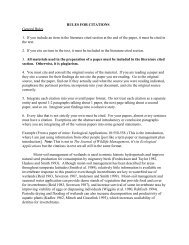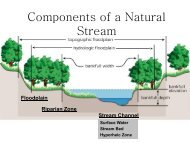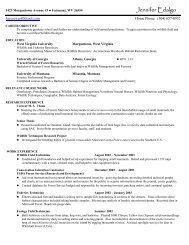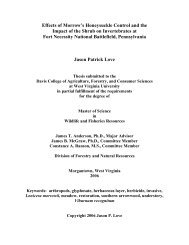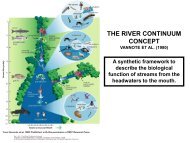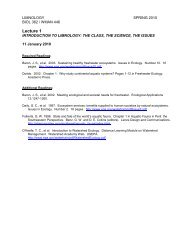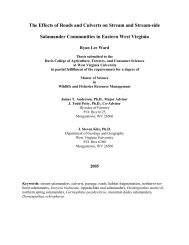An Experimental Study of Vertical Habitat Use and Habitat Shifts in ...
An Experimental Study of Vertical Habitat Use and Habitat Shifts in ...
An Experimental Study of Vertical Habitat Use and Habitat Shifts in ...
Create successful ePaper yourself
Turn your PDF publications into a flip-book with our unique Google optimized e-Paper software.
Introduction<br />
Non-native fishes negatively impact native populations through multiple<br />
pathways (Meffe 1985, Ross 1991, Mooney <strong>and</strong> Clel<strong>and</strong> 2001), <strong>in</strong>clud<strong>in</strong>g competition for<br />
food or space (Hocutt <strong>and</strong> Hambrick 1973, Mathur 1975, Walser et al. 2000). Follow<strong>in</strong>g<br />
ecological theories <strong>of</strong> competitive exclusion (Hard<strong>in</strong> 1960), limit<strong>in</strong>g similarity<br />
(MacArthur <strong>and</strong> Lev<strong>in</strong>s 1967) <strong>and</strong> niche (Pielou 1972, Pianka 1974), competitive<br />
<strong>in</strong>teractions are expected between non-native species <strong>and</strong> closely-related native species.<br />
Aquarium-based studies <strong>of</strong> vertical segregation <strong>in</strong> m<strong>in</strong>nows have emphasized expected<br />
similarities with<strong>in</strong> behaviors <strong>and</strong> habitat use <strong>of</strong> closely-related species (i.e., an historical<br />
ecology emphasis on phylogenetic constra<strong>in</strong>ts on habitat use, Gorman 1988, 1992). Also,<br />
researchers have emphasized morphological correlates on use <strong>and</strong> segregation <strong>of</strong> habitats<br />
among closely-related species, such as mouth position <strong>and</strong> its determ<strong>in</strong>istic <strong>in</strong>fluence on<br />
benthic, pelagic, or surface forag<strong>in</strong>g (Mendelson 1975, Surat et al. 1982, Page <strong>and</strong><br />
Sw<strong>of</strong>ford 1984). Alternatively, some closely-related species <strong>in</strong>tegrate as mixed-species<br />
shoals, such as m<strong>in</strong>nows (Cypr<strong>in</strong>idae), <strong>and</strong> this strategy may improve forag<strong>in</strong>g success or<br />
predator avoidance (Mendelson 1975, Magurran <strong>and</strong> Pitcher 1983, 1987). Multispecific<br />
aggregations suggest a historic legacy <strong>of</strong> strong behavioral relationships amongst<br />
cypr<strong>in</strong>id guilds. Both mutual responsiveness <strong>and</strong> selective forces, required to reduce<br />
competition <strong>and</strong> ma<strong>in</strong>ta<strong>in</strong> species identity, are required for mixed-species shoals to<br />
function (Mendelson 1975). However, little is known <strong>of</strong> the occurrence <strong>and</strong><br />
consequences <strong>of</strong> mixed-species shoals <strong>of</strong> native <strong>and</strong> non-native m<strong>in</strong>nows. Given recent<br />
conservation concerns <strong>of</strong> fish <strong>in</strong>troductions <strong>and</strong> impacts <strong>of</strong> non-natives (Rahel 2000),<br />
additional research needs focused on native/non-native species <strong>in</strong>teractions.<br />
32



